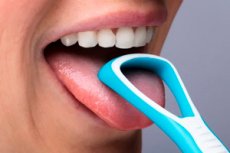New publications
How Tongue Coating Helps Identify Parkinson's Disease Early
Last reviewed: 03.08.2025

All iLive content is medically reviewed or fact checked to ensure as much factual accuracy as possible.
We have strict sourcing guidelines and only link to reputable media sites, academic research institutions and, whenever possible, medically peer reviewed studies. Note that the numbers in parentheses ([1], [2], etc.) are clickable links to these studies.
If you feel that any of our content is inaccurate, out-of-date, or otherwise questionable, please select it and press Ctrl + Enter.

By analysing what's on the surface of the tongue, scientists have discovered powerful clues to detect Parkinson's disease: no injections, no scans - just a simple swab.
Researchers from Shanghai Jiao Tong University School of Medicine, China, have explored the diagnostic potential of tongue coating samples for the early detection and monitoring of Parkinson's disease. In their study, published in Frontiers in Microbiology, tongue coating samples have emerged as a promising diagnostic tool for the disease, highlighting the involvement of microbial communities and metabolic compounds in the pathogenesis.
Introduction
Parkinson's disease is the second most common neurodegenerative disorder, characterized by resting tremor, muscle rigidity, and slowness of movement. In high-income countries, the incidence is approximately 14 cases per 100,000 people.
The pathogenesis is associated with mitochondrial dysfunction, oxidative stress, protein aggregation, autophagy impairment, and neuroinflammation. Such complexity of pathogenesis limits diagnostic and therapeutic options.
Traditional diagnostic methods require the collection of cerebrospinal fluid or blood, which are invasive procedures that can cause psycho-emotional stress, financial burden and risk of infection, and are also expensive and associated with complex protocols.
These shortcomings highlight the need to develop more convenient, accurate, and early diagnostic methods. This study was conceived with this goal in mind. The idea came about when scientists noticed a characteristic tongue coating in patients with Parkinson's disease — a thick, greasy layer, sometimes with an abnormal white or yellow tint.
Tongue coating is an important object of "visual diagnostics" in traditional Chinese medicine. It usually contains a mixture of bacteria, epithelial cells, saliva, blood metabolites and food debris.
Tongue coating analysis is gaining increasing attention in the biomedical field and is used to diagnose oral diseases, gastrointestinal diseases, and many other conditions.
Considering the simplicity, non-invasiveness, low risk and cost-effectiveness of tongue swab, researchers from Shanghai Jiaotong University conducted a compositional analysis to improve the diagnosis and prognosis of Parkinson's disease.
Methodology
Scientists conducted a quantitative analysis of the microbiome and metabolic compounds in tongue plaque samples from 36 patients with Parkinson's disease and 31 healthy individuals.
By integrating microbiome and metabolomics data, they aimed to identify reliable biomarkers that could serve as non-invasive diagnostic tools and point to new therapeutic targets. To assess the predictive value of the identified markers, a Random Forest machine learning model was used.
Key Results
- Microbiome: Plaque analysis revealed significant differences in the relative abundance of several bacterial communities between patients and healthy controls, including Firmicutes, Bacteroidetes, and Actinobacteria. These communities may serve as potential markers of pathophysiological changes in Parkinson's disease.
- Metabolomics. Decreased levels of palmitoylethanolamide were found in plaque in Parkinson's patients and decreased levels of carnitine in patients with advanced disability and mild cognitive impairment. Palmitoylethanolamide is an endogenous fatty acid amide that has been widely studied in neurodegenerative diseases.
- Artifact: Elevated docosanamide levels were detected, but were considered to be due to external contamination and were not considered a reliable marker.
Significance of the study
The study identified a potential link between changes in the microbiota composition and metabolic profile of the tongue coating, which may significantly influence the pathogenesis and progression of Parkinson's disease.
Plaque imaging has been previously used to detect oral and gastrointestinal diseases, rheumatoid arthritis, pneumonia, lung cancer, chronic kidney disease, heart disease, osteoporosis, and ischemic stroke. For the first time, the current study focuses on the composition of tongue plaque changes in patients with Parkinson's disease, offering molecular insights into pathogenesis.
The changes in plaque microbiota were similar to those reported for faecal samples from Parkinson's patients. Tongue plaque collection is more convenient, cleaner, and safer than faecal collection, further highlighting the benefits of this approach.
Of the metabolic changes, the most significant were an increase in some exogenous compounds and a decrease in endogenous palmitoylethanolamide, indicating the influence of both external and internal factors on the patients' condition.
The decrease in palmitoylethanolamide in plaque makes it a promising marker for differentiating patients with and without Parkinson's disease. Palmitoylethanolamide is synthesized by neurons and glial cells of the central nervous system, maintains the integrity of the intestinal barrier, reduces inflammation and pain, and regulates energy metabolism.
Carnitine is also important: its decrease in patients with late stages and mild cognitive impairment confirms the previously described neuroprotective and cognitive-enhancing properties.
Limitations and Prospects
The study is preliminary and based on a small sample size, so validation in larger cohort studies is needed.
The Random Forest model showed nearly 89% accuracy in discriminating between Parkinson's patients and healthy participants, confirming the diagnostic potential of plaque metabolic profiling.
Overall, the results highlight the potential of tongue coating as a non-invasive, cost-effective tool for diagnosing and monitoring Parkinson's disease. However, further large-scale studies are needed to confirm the clinical utility of these markers.
